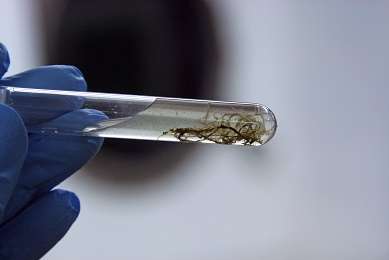Strangers invade the homes of giant bacteria

Life is not a walk in the park for the world's largest bacteria, that live as soft, noodle-like, white strings on the bottom of the ocean depths. Without being able to fend for themselves, they get invaded by parasitic microorganisms that steal the nutrition, that they have painstakingly retreived. This newly discovered bizarre deep ocean relationship may ultimately impact ocean productivity, report researchers from University of Southern Denmark now in the scientific journal Nature.
At the bottom of the eastern Pacific off Mexico we find one of the largest bacteria in the world: Thioploca. It is so large that it can be seen with the naked eye, and it lives together with other family members in bundles of long fluffy white cell strands that look like Chinese noodles. Thioploca feeds on nitrate, which it absorbs from the water, and when it has gathered a portion of nitrate, it retires to a dwelling site under the seabed. The bacteria withdraws through an up to 20 cm long sheath to its dwelling site, and when it is again ready to feed, it returns through the tube to the ocean water.
"We have long thought that a surprisingly large amount of nitrate disappears here. When we investigated the case, we saw that Thioploca is not solely responsible for all nitrate removal. Inside the tubes we found some smaller cells, so-called anammox bacteria that steal nitrate from Thioploca when it retires through the sheath with its harvest of nitrate", explains Bo Thamdrup, bio-geo-chemist at the Nordic Center for Earth Evolution (NordCEE), University of Southern Denmark.
Along with colleagues from Pomona College in California and other American institutions, he describes the newly discovered symbiosis in the journal Nature.
The discovery is now helping to explain why in some parts of the oceans large quantities of nutrients disappear.
"The newly discovered symbiotic relationship increases nitrogen metabolism in the sea. This leads to fewer algae in the water and thus less food for marine organisms. The consequence is that there is less food for the fish", explains Bo Thamdrup.
It is often an accelleration rather than a reduction of algal growth that worries marine scientists, because algal blooms can lead to poor and potentially deadly conditions for marine animals, including fish, particularly in coastal waters. But in some places in the world - as in the area, that Bo Thamdrup and his colleagues have studied - it is not increased but reduced algal growth, which leads to poorer living conditions for the fish.
The research team studied the seabed off Mexico, where a large area of the ocean is extremely low in oxygen. Only bacteria that feed on nitrate instead of oxygen can live here.
"We have previously believed that nitrogen removal occured mainly in the open ocean and in the water column rather than at the bottom. However, if oxygen-depleted regions and Thioploca and anammox-bacteria spread over the seabed near the coasts, it could have implications for fish life and fisheries" explains Bo Thamdrup.
More information: Nitrogen unloaded in anoxic marine sediments driven by Thioploca / anammox bacterial Consortia, Nature, 8 August 2013.
Journal information: Nature
Provided by University of Southern Denmark



















